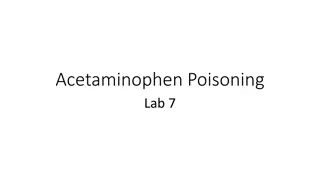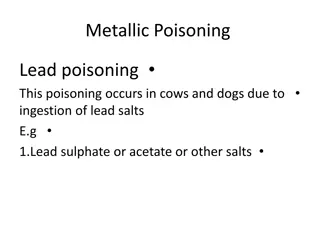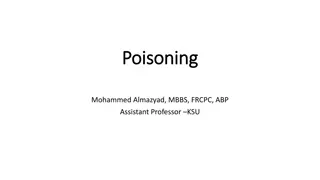Helping Legislators Get Support for Their Bills To Curb Lead Poisoning
Legislators are pushing for bills to combat lead poisoning, focusing on children under six and lead abatement programs in housing. An event was organized to research legislative gaps and connect with organizations. Key topics include lead in various areas and potential solutions like accessing fundi
0 views • 8 slides
Global Sodium Cyanide Market
The Global Sodium Cyanide Market Size is Anticipated to Exceed USD 3491.55 Million by 2033, Growing at a CAGR of 4.40% from 2023 to 2033. \n\n
0 views • 5 slides
Understanding Acetaminophen Poisoning: Mechanism, Toxicity, and Treatment
Acetaminophen poisoning occurs when the body is overwhelmed by high doses of the drug, leading to liver toxicity and potentially fatal consequences. The mechanism of toxicity involves the depletion of glutathione and the formation of a harmful metabolite, N-acetyl-para-benzoquinoneimine (NAPQI). Con
2 views • 9 slides
Benzoin Condensation: A Name Reaction Explained by Dr. Atul Kumar Singh
Benzoin condensation is a classic organic reaction where aromatic aldehydes self-condense to form α-hydroxy ketones. Dr. Atul Kumar Singh, an Assistant Professor of Chemistry, details the mechanism and the specific catalytic properties of cyanide in this reaction. The reaction involves refluxing th
0 views • 6 slides
Understanding Scorpion Poisoning: Composition, Toxicity, and Mechanism of Action
Scorpion poisoning is a serious issue presented by Meriam Nabil Nasseif, Assistant Lecturer of Clinical Toxicology at Minia University. This comprehensive guide explores the physical properties of scorpions, the composition of their venom, toxicity effects on the human body, and the intricate mechan
0 views • 23 slides
Lead Poisoning Prevention in Child Care Settings
Lead poisoning is a significant concern for children, particularly those under six years old. Exposure to lead can have severe consequences on their health and development. This resource provides important insights on identifying and minimizing lead exposure risks in child care environments. It emph
0 views • 18 slides
Childhood Lead Poisoning Prevention Program Overview
This content highlights the importance of preventing childhood lead poisoning, discussing its risks, health effects, sources, and testing methods. It emphasizes the need for early detection and provides essential information for parents and caregivers on reducing lead exposure in young children.
0 views • 26 slides
Lead Poisoning Investigation and Remediation in Child-Occupied Facilities
Explore the protocols and requirements for lead investigations, remediation efforts, routine sanitation inspections, and monitoring in child care centers and schools to ensure the safety of children from lead hazards. Learn about lead poisoning thresholds, hazard identification, XRF testing, and mor
0 views • 25 slides
Lead Testing and Reduction Program Overview in Missouri
Missouri's Lead Testing and Reduction Program, funded by the WIIN Grant, aims to address lead poisoning in young children. The program involves voluntary lead testing in schools and child care facilities, focusing on high-risk areas. Steps include application submission, staff training, water testin
1 views • 6 slides
Lead Poisoning Prevention Resources for Families and Homeowners
Explore a variety of helpful resources on lead poisoning prevention, including tipsheets covering topics like lead testing, dust cleanup, and hazard identification. Discover educational materials such as DVDs, booklets, and brochures to assist families and homeowners in safeguarding against lead exp
0 views • 14 slides
Chemical Factors: Carbon Monoxide Poisoning and Smoking Risks
Chemical factors such as carbon monoxide poisoning from indoor sources like tobacco smoking and poorly ventilated appliances can lead to serious health risks. Recognizing the signs of CO poisoning, understanding the dangers of cigarette smoke, and addressing the addictive nature of smoking are cruci
0 views • 17 slides
Understanding Cyanide: Sources, Exposure, and Risks
Cyanide is a toxic compound found in various forms such as gases, solids, and liquids that can be harmful to humans and animals. Sources of cyanide exposure include natural processes, industrial activities, plant sources, and combustion products like cigarette smoke. The extent of poisoning depends
0 views • 14 slides
Understanding Food Poisoning and Its Causes
Food poisoning is a common threat that can be prevented with proper food handling. It is caused by various microorganisms, natural toxins, and chemical residues. The illness is characterized by rapid onset of symptoms like vomiting and diarrhea. Common bacteria causing food poisoning include Staphyl
0 views • 27 slides
Understanding Datura Poisoning: Effects, Management, and Treatment
Datura, a genus of flowering plants, contains toxic alkaloids like scopolamine and atropine, causing severe symptoms ranging from dermatitis to hallucinations. Identifying datura seeds versus chili seeds, distinguishing signs of poisoning, managing fatal doses, and treatment methods like purgatives
0 views • 22 slides
Earth's Geological Processes and Environmental Impact of Mining
Earth's geological processes involve the formation and movement of tectonic plates, creating divergent and convergent boundaries, leading to events like earthquakes and volcanic eruptions. Gold mining, a process that extracts small amounts of gold from large quantities of rock using cyanide leaching
0 views • 51 slides
Investigating Agent Z's Poisoning: A Case of Radioactive Decay
Agent Z, a double spy, was poisoned with Polonium-210, a heavy, radioactive element. This task challenges students to analyze the cause of his death using concepts of nuclear decay and half-life modeling based on provided data and models. The scenario involves understanding the effects of radioactiv
0 views • 14 slides
North Carolina Childhood Lead Poisoning Prevention Program Updates
The North Carolina Childhood Lead Poisoning Prevention Program, managed by Ed Norman, MPH, is implementing proposed temporary rules and receiving funds for lead testing and remediation. Public schools and licensed child care facilities are affected by the regulations, with specific requirements for
2 views • 8 slides
Mastering Good Food Hygiene and Storage Practices
Understanding food spoilage causes, common food-poisoning bacteria, conditions for bacterial growth, ways to prevent food contamination, safe food handling practices, HACCP concept, types of perishable foods, importance of proper food storage, packaging materials for food, and recognizing signs of f
1 views • 27 slides
Cardiotoxic Glycosides in Plants: Toxicity and Mechanism of Action - Overview
Plants like Nerium oleander, Thevetia peruviana contain cardiotoxic glycosides causing toxicity in animals and humans. Poisoning with these plants can be fatal, affecting the heart and nerves. Toxicity is mainly due to compounds like oleandroside and oleandrin, leading to cardiac failure and gastroi
0 views • 13 slides
Mercury: Environmental Impact and Human Health
Mercury, a potent environmental pollutant, poses significant risks to human health. This overview explores the origins of mercury poisoning throughout history, including notable incidents such as the Minamata disaster and modern-day cases like Jeremy Piven's and Richard Gelfond's struggles with merc
0 views • 16 slides
Understanding Kitchen Hygiene and Food Safety
Kitchen hygiene and food safety are crucial to prevent food spoilage and food poisoning. Factors like enzymes, micro-organisms, and oxygen can lead to food spoilage, while food poisoning occurs when pathogenic bacteria multiply in consumed food. Practicing proper hygiene, storage, and preparation me
0 views • 27 slides
Understanding Heavy Metal Toxicity: Lead and Mercury Poisoning
Lead and mercury poisoning are serious health concerns caused by exposure to these toxic heavy metals. Lead, commonly found in products like batteries and paints, can lead to developmental delays, abdominal pain, and more. On the other hand, mercury, present in various forms, can cause symptoms such
0 views • 6 slides
Cyanide's Impact on Respiration Through Enzyme Inhibition
Cyanide, a noncompetitive inhibitor of the enzyme cytochrome c oxidase, disrupts electron transport in respiration by binding to the iron cofactor and blocking electron transfer to oxygen. This lethal effect was utilized in gas chambers during WWII, underscoring the crucial role of enzyme function i
0 views • 7 slides
Understanding Statistical Modeling in Food Poisoning Analysis
Statistical modeling is used to determine excess risks associated with different food items in cases of food poisoning. By calculating attack rates and risks, it is possible to identify which food items may be contributing to the illness. The approach is explained through examples and comparisons, h
0 views • 14 slides
Understanding Metallic Poisoning in Animals: Lead and Mercury
Metallic poisoning, specifically lead and mercury poisoning in animals, can result from ingestion of lead salts or mercury compounds. Symptoms, effects on the body, absorption, excretion, and treatment methods for these toxicities are discussed in detail to enhance awareness and understanding of the
0 views • 40 slides
The Many Faces of Gold: Properties, Production, and Ecological Risks
Gold, a yellow, glossy, and durable metal, is highly conductive and resistant to corrosion. It reacts only with aqua regia and is found in pure form in rocks or as an alloy with silver. Gold mining involves cyanide leaching, primarily in South Africa, the Urals, and Australia. However, it poses ecol
0 views • 12 slides
Reactor Xenon Poisoning and Iodine Pit Phenomenon
When a non-stationary reactor is shut down or its load is reduced to zero, xenon poisoning occurs due to the disruption of dynamic equilibrium between the increase and decrease of 135Xe. This leads to a temporary increase in 135Xe concentration, followed by a decrease as it decays. The reactivity ma
0 views • 58 slides
Protecting Against Carbon Monoxide Poisoning in Buildings
Carbon monoxide (CO) is a silent killer that results from incomplete combustion of fossil fuels. Exposure to high levels of CO can be fatal, leading to deaths and illnesses every year. The Department of Community Affairs in NJ has enforced regulations for the installation of CO detectors in all buil
0 views • 25 slides
Pediatric Poisoning: Epidemiology, Approach, and Management
Explore the epidemiology of pediatric poisoning, including common causes and age groups affected. Learn about the approach to a poisoned child, emphasizing history-taking, physical examination, and management principles. Discover key factors such as the setting of toxic exposures, the importance of
0 views • 50 slides
Approach to Poisoning in Children: Epidemiology, History, and Management
Epidemiology of poisoning in children, including common causes and age distribution, is discussed. The approach to poisoned children involves stabilization, targeted history taking, and examination to identify potential toxins and assess the severity of poisoning. Key aspects of history include onse
0 views • 51 slides
Lead-Free Voluntary Incentive Pilots for Wildlife Conservation
Focusing on addressing lead poisoning in wildlife, the Lead-Free Voluntary Incentive Pilots program aims to test lead-free incentives on National Wildlife Refuges. With key objectives to kick-start the program, test variations among pilot sites, and compile lessons for future pilots, the initiative
0 views • 13 slides
STEMM Student Challenge 2018 - Senior Section (Years 11-13) Questions and Answers
Explore challenging questions from the STEMM Student Challenge 2018 for students in the senior section (Years 11-13). Discover interesting facts about physics, dwarfs, poisoning, elements, and more. Test your knowledge with answers ranging from Heinrich Hertz to lead poisoning.
0 views • 114 slides
Understanding Benzoin Condensation and Green Chemistry Aspects
Enzymes play a vital role in catalyzing organic reactions in biological systems. Benzoin condensation can be achieved using cyanide or thiamine, with thiamine offering a greener alternative. The mechanism involves the formation of a Breslow intermediate. Understanding the risks associated with cyani
0 views • 10 slides
Comprehensive Guide to Overdose and Poisoning Management
Poisoning and overdose are common occurrences with serious implications. They encompass various toxidromes and require a systematic approach covering risk assessment, resuscitation, investigations, supportive care, decontamination, antidotes, and disposition planning. Recognizing signs of poisoning
0 views • 25 slides
Understanding Carbon Monoxide Poisoning: Risks, Symptoms, and Guidelines
Carbon monoxide poisoning is often unrecognized and underdiagnosed, leading to serious health risks including chronic symptoms if left untreated. This article discusses the prevalence, symptoms, long-term effects, WHO guidelines, UK workplace guidelines, and CO levels in various environments. Awaren
1 views • 96 slides
Understanding Cyanogenic Plants and Cyanide Poisoning in Animals
This lecture introduces the toxicology of plants containing cyanide, focusing on factors affecting cyanide poisoning, cyanogenic plants, mechanisms of toxicosis, clinical signs, post-mortem lesions, diagnosis, treatment, and prevention. It discusses species variations in susceptibility, plant growth
0 views • 22 slides
Comparative Analysis of Injury Statistics Between Colorado and National Data
This study compares injury statistics between Colorado and national data, focusing on injury deaths, hospitalizations, and diagnosis codes. The purpose is to analyze NHDS and HCUPNet data for national estimates, highlighting differences in hospital discharges for various injury categories. The analy
0 views • 13 slides
Navigating Narratives: Analysing the Navalny Poisoning Debate in Russia
An analysis of the contentious narratives surrounding the poisoning, return, and arrest of Russian opposition leader Alexei Navalny, exploring how public debates construct binary oppositions, manipulate trust, and create alternative facts. Using discourse analysis and the Narrative Policy Framework,
0 views • 15 slides
CO Poisoning Safety Scenario and Prevention Guidelines
Your lab mate appears pale and unwell after working with CO. Understand the symptoms of CO poisoning, the binding affinity of CO to hemoglobin, and the necessary course of action for prevention and response. Stay vigilant in detecting CO, ensuring proper ventilation, and taking immediate action in c
0 views • 4 slides
The Tragedy of Minamata: A History of Mercury Poisoning
The Minamata Disaster was a tragic event in Japan's history, stemming from mercury poisoning caused by industrial waste disposal. The Chisso Corporation's chemical factory in Minamata released methyl mercury into Minamata Bay, leading to widespread poisoning in humans and animals. The identification
0 views • 45 slides







































